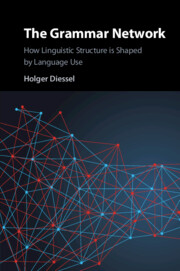Book contents
- The Grammar Network
- The Grammar Network
- Copyright page
- Contents
- Figures
- Tables
- Preface
- Abbreviations
- 1 Introduction
- Part I Foundations
- Part II Signs as Networks
- Part III Filler–Slot Relations
- 7 Argument Structure and Linguistic Productivity
- 8 A Dynamic Network Model of Parts of Speech
- 9 Phrase Structure
- Part IV Constructional Relations
- References
- Author Index
- Subject Index
8 - A Dynamic Network Model of Parts of Speech
from Part III - Filler–Slot Relations
Published online by Cambridge University Press: 12 August 2019
- The Grammar Network
- The Grammar Network
- Copyright page
- Contents
- Figures
- Tables
- Preface
- Abbreviations
- 1 Introduction
- Part I Foundations
- Part II Signs as Networks
- Part III Filler–Slot Relations
- 7 Argument Structure and Linguistic Productivity
- 8 A Dynamic Network Model of Parts of Speech
- 9 Phrase Structure
- Part IV Constructional Relations
- References
- Author Index
- Subject Index
Summary
Chapter 8 extends the network analysis of argument structure to the analysis of parts of speech. Traditionally, parts of speech are analyzed as classes of lexical items with the same or similar structural properties, but the structural criteria that are used to define the major parts of speech (e.g., the occurrence of certain function words or inflectional affixes) can also be seen as properties of particular slots of constructional schemas. Crucially, while the slots of word class schemas are commonly defined by distributional criteria, they are not merely structural concepts but evoke particular conceptualizations. Combining research from cognitive linguistics with research from typology, the chapter argues that the major parts of speech are best analyzed in the framework of a network model in which particular lexical items are linked to particular word class schemas. The bulk of the analysis is concerned with the three major parts of speech (i.e., nouns, verbs, adjectives), but the chapter also includes a section on grammaticalization that explains how grammatical function words are derived from content words (and demonstratives) in a dynamic network model.
Keywords
- Type
- Chapter
- Information
- The Grammar NetworkHow Linguistic Structure Is Shaped by Language Use, pp. 142 - 171Publisher: Cambridge University PressPrint publication year: 2019



